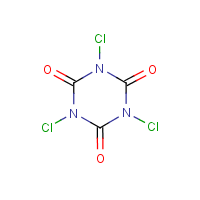Trichloroisocyanuric acid
Agent Name
Trichloroisocyanuric acid
Alternative Name
Symclosene
CAS Number
87-90-1
Formula
C3-Cl3-N3-O3
Major Category
Other Uses

Synonyms
Symclosene; 1,3,5-Triazine, 2,4,6(1H,3H,5H)-trione, 1,3,5-trichloro-; 1,3,5-Trichloro-2,4,6-trioxohexahydro-s-triazine; 1,3,5-Trichloro-s-triazine-2,4,6(1H,3H,5H)-trione; 1,3,5-Trichloro-s-triazinetrione; 1,3,5-Trichloroisocyanuric acid; Chloreal; Fi Clor 91; Fichlor 91; Isocyanuric chloride; Kyselina trichloisokyanurova [Czech]; N,N',N"-Trichloroisocyanuric acid; Neochlor 90; Sincloseno [INN-Spanish]; Symclosen; Symclosene; Symclosenum [INN-Latin]; Trichlorinated isocyanuric acid; Trichlorisocyanursaeure; Trichloro-s-triazine-2,4,6(1H,3H,5H)-trione; Trichloro-s-triazinetrione; Trichlorocyanuric acid; Trichloroisocyanurate; s-Triazine-2,4,6(1H,3H,5H)-trione, 1,3,5-trichloro-; [ChemIDplus] TCC; TCCA; [CHEMINFO] UN2468
Category
Biocides/Disinfectants
Description
White solid; [ICSC] Strong odor of chlorine; Slightly hygroscopic; [HSDB]
Sources/Uses
Used in swimming pool sanitizers, industrial deodorants, bleaches, scouring powders, and dishwashing compounds; [HSDB] Used as a disinfectant, chlorinating agent, stainless steel cleaner, and non-shrink agent for wool; [Merck Index]
Comments
Forms hypochlorous acid on contact with water; A moderate skin, eye, and mucous membrane irritant; [Merck Index] A strong oxidant that reacts violently with combustible substances; Decomposed by water forming hypochloric acid and cyanuric acid; A mild skin irritant; A severe eye and respiratory tract irritant; Inhalation of dust or decomposition products may cause pulmonary edema; [ICSC] Irritating to skin, eyes, and respiratory tract; Estimated lethal oral dose = 1 ounce to 1 pint for a 150 lb. person; Oral LD50 (rat) = 406 mg/kg; Skin LD50 (rabbit) = 20,000 mg/kg; [HSDB] A strong oxidizing agent; May react with water producing chlorine gas; May cause skin and eye irritation; [CAMEO] A skin, eye, and respiratory tract irritant; May cause corrosive injuries on prolonged contact with skin and eyes; [CHEMINFO] A skin irritant; Corrosive to eyes; [eChemPortal: ERMA] An eye and respiratory tract irritant; [eChemPortal: ESIS] An oxidizing agent; May cause fire on contact with combustible material; An irritant; May cause corrosive injuries; [MSDSonline] See "Sodium cyanurate" and "Sodium dichloroisocyanurate."
Reference Link #1
Biomedical References
Exposure Assessment
Vapor Pressure
1.25E-07 mm Hg
Lethal Concentration
LC (rat) > 2,000 mg/m3/1h
NFPA
will not burn
Adverse Effects
Toxic Pneumonitis
Yes
Dermatotoxin
Skin burns
Diseases, Processes, and Activities Linked to This Agent
Processes
Industrial Processes with risk of exposure: